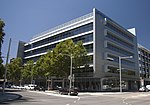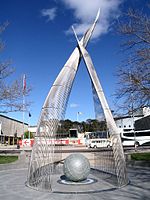Casino Canberra

Casino Canberra (or Canberra Casino) is a casino located in the Central Business District of Canberra, the capital city of Australia. It was the first legal casino to open in the Australian Capital Territory, built on land excised from Glebe Park under a 99-year lease agreement between the casino licensee and the territory government. It is small in comparison with other casinos in Australia and does not incorporate any hotel accommodation, theatres, auditoriums or retail stores. It is the only casino in Australia not licensed to operate poker machines. There are 39 gaming tables where blackjack, roulette, baccarat and other games are played. The casino also has a poker lounge and sports lounge with TAB facilities.
Excerpt from the Wikipedia article Casino Canberra (License: CC BY-SA 3.0, Authors, Images).Casino Canberra
Binara Street, Canberra City
Geographical coordinates (GPS) Address Nearby Places Show on map
Geographical coordinates (GPS)
| Latitude | Longitude |
|---|---|
| N -35.2833 ° | E 149.1344 ° |
Address
Crowne Plaza
Binara Street 21
2601 Canberra, City
Australia
Open on Google Maps






